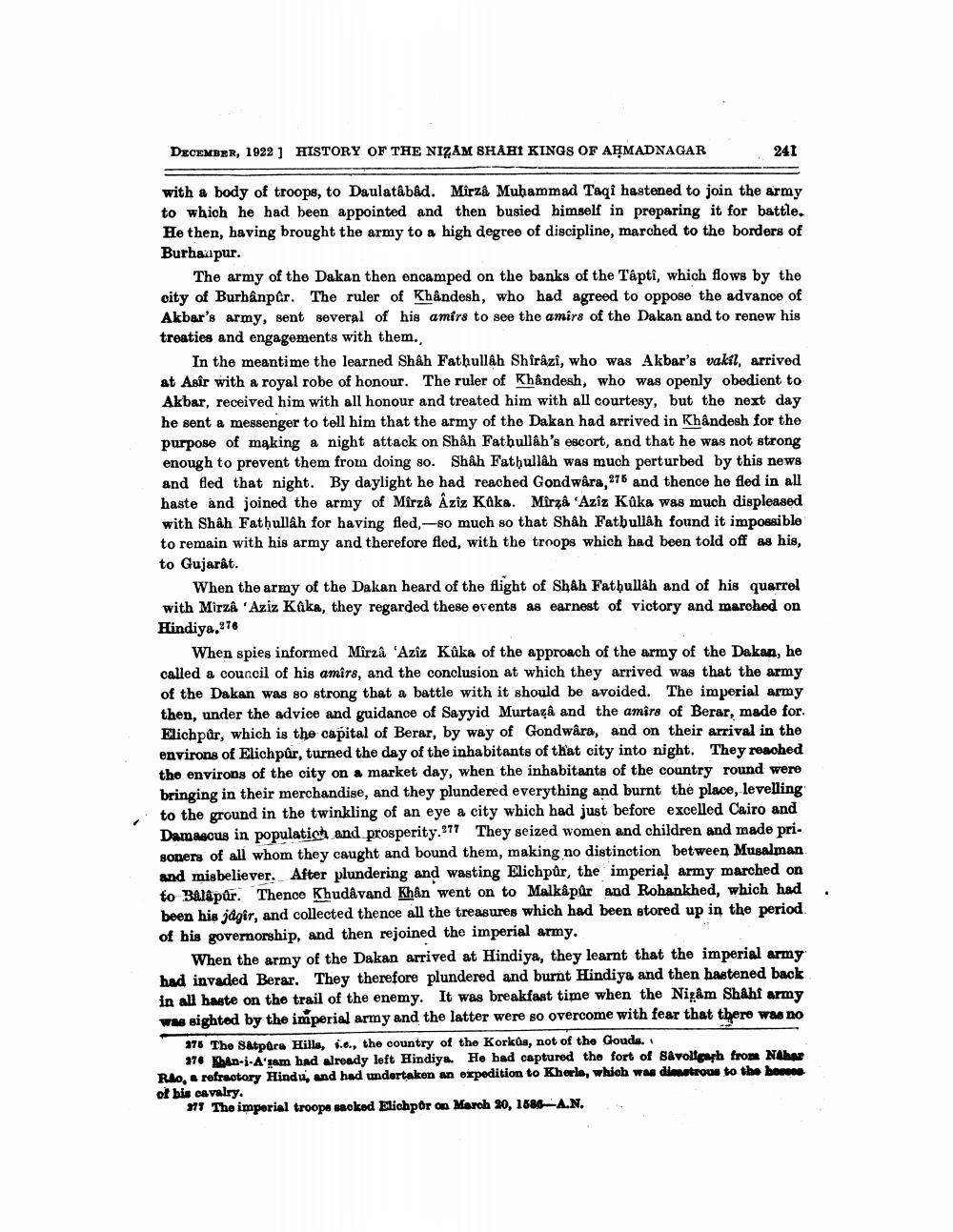________________
DECEMBER, 1022] HISTORY OF THE NIZAM SHAH KINGS OF AHMADNAGAR
2 41
with a body of troops, to Daulatâbâd. Mirza Muhammad Taqi hastened to join the army to which he had been appointed and then busied himself in preparing it for battle. He then, having brought the army to a high degree of discipline, marched to the borders of Burhanpur.
The army of the Dakan then encamped on the banks of the Tápts, which flows by the city of Burhanpar. The ruler of Khandesh, who had agreed to oppose the advance of Akbar's army, sent several of his amirs to see the amirs of the Dakan and to renew his treaties and engagements with them.,
In the meantime the learned Shah Fathullah Shîrâzi, who was Akbar's vakil. arrived at Asir with a royal robe of honour. The ruler of Khåndesh, who was openly obedient to Akbar, received him with all honour and treated him with all courtesy, but the next day he sent a messenger to tell him that the army of the Dakan had arrived in Khandesh for the purpose of making a night attack on Shâh Fathullah's escort, and that he was not strong enough to prevent them from doing so. Shâh Fathullâh was much perturbed by this news and fled that night. By daylight he had reached Gondwara, 276 and thence he fled in all haste and joined the army of Mirza Aziz Kaka. Mîrzà 'Aziz Kûka was much displeased with Shah Fathullah for having fled,-so much so that Shah Fatbullâh found it impossible to remain with his army and therefore fled, with the troops which had been told off as his, to Gujarat.
When the army of the Dakan heard of the flight of Shah Fathullah and of his quarrel with Mirza Aziz Kaka, they regarded these events as earnest of victory and marched on Hindiya.276
When spies informed Mirza 'Aziz Kûka of the approach of the army of the Dakan, he called a council of his amirs, and the conclusion at which they arrived was that the army of the Dakan was so strong that a battle with it should be avoided. The imperial army then, under the advice and guidance of Sayyid Murtaza and the amirs of Berar, made for Elich půr, which is the capital of Berar, by way of Gondwara, and on their arrival in the environs of Elichpûr, turned the day of the inhabitants of that city into night. They reached the environs of the city on a market day, when the inhabitants of the country round were bringing in their merchandise, and they plundered everything and burnt the place, levelling to the ground in the twinkling of an eye a city which had just before excelled Cairo and Damascus in populatich and prosperity:977 They seized women and children and made prisoners of all whom they caught and bound them, making no distinction between Musalman and misbeliever. After plundering and wasting Elichpûr, the imperial army marched on to Balapur. Thence Khudavand Khân went on to Malkapûr and Rohankhed, which had been his jagir, and collected thence all the treasures which had been stored up in the period of his governorship, and then rejoined the imperial army.
When the army of the Dakan arrived at Hindiya, they learnt that the imperial army had invaded Berar. They therefore plundered and burnt Hindiya and then hastened back in all haste on the trail of the enemy. It was breakfast time when the Nizâm Shahf army was sighted by the imperial army and the latter were so overcome with fear that there was no
378 The Satpora Hills, 8.o., the country of the Korkus, not of the Gouda.
370 Khan-i-A'sam had already left Hindiye. He had captured the fort of Bavollpaph from Nihar Rho, refractory Hindu, and had undertaken an expedition to Kherle, which was dicastrous to the bene of bis cavalry.
311 The imperial troopa saoked Elichpor on March 20, 168–A.N.




